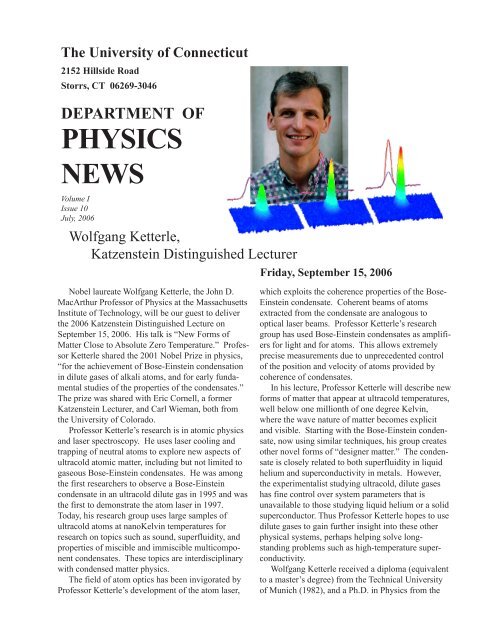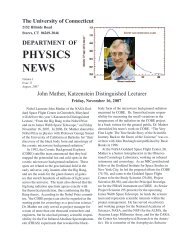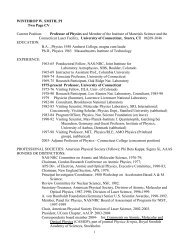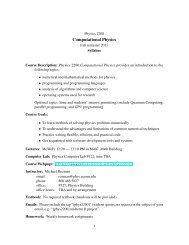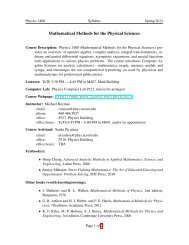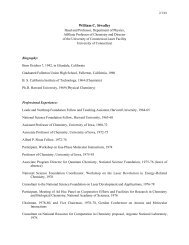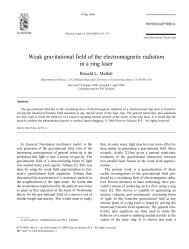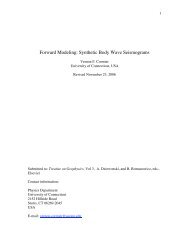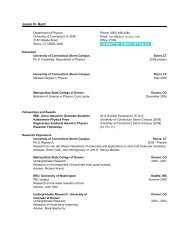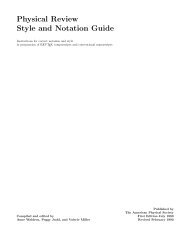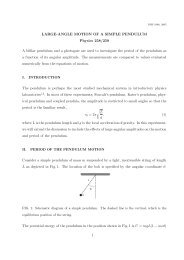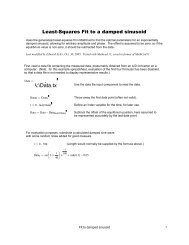physics news - the Department of Physics - University of Connecticut
physics news - the Department of Physics - University of Connecticut
physics news - the Department of Physics - University of Connecticut
You also want an ePaper? Increase the reach of your titles
YUMPU automatically turns print PDFs into web optimized ePapers that Google loves.
The <strong>University</strong> <strong>of</strong> <strong>Connecticut</strong><br />
2152 Hillside Road<br />
Storrs, CT 06269-3046<br />
DEPARTMENT OF<br />
PHYSICS<br />
NEWS<br />
Volume I<br />
Issue 10<br />
July, 2006<br />
Wolfgang Ketterle,<br />
Katzenstein Distinguished Lecturer<br />
Friday, September 15, 2006<br />
Nobel laureate Wolfgang Ketterle, <strong>the</strong> John D.<br />
MacArthur Pr<strong>of</strong>essor <strong>of</strong> <strong>Physics</strong> at <strong>the</strong> Massachusetts<br />
Institute <strong>of</strong> Technology, will be our guest to deliver<br />
<strong>the</strong> 2006 Katzenstein Distinguished Lecture on<br />
September 15, 2006. His talk is “New Forms <strong>of</strong><br />
Matter Close to Absolute Zero Temperature.” Pr<strong>of</strong>essor<br />
Ketterle shared <strong>the</strong> 2001 Nobel Prize in <strong>physics</strong>,<br />
“for <strong>the</strong> achievement <strong>of</strong> Bose-Einstein condensation<br />
in dilute gases <strong>of</strong> alkali atoms, and for early fundamental<br />
studies <strong>of</strong> <strong>the</strong> properties <strong>of</strong> <strong>the</strong> condensates.”<br />
The prize was shared with Eric Cornell, a former<br />
Katzenstein Lecturer, and Carl Wieman, both from<br />
<strong>the</strong> <strong>University</strong> <strong>of</strong> Colorado.<br />
Pr<strong>of</strong>essor Ketterle’s research is in atomic <strong>physics</strong><br />
and laser spectroscopy. He uses laser cooling and<br />
trapping <strong>of</strong> neutral atoms to explore new aspects <strong>of</strong><br />
ultracold atomic matter, including but not limited to<br />
gaseous Bose-Einstein condensates. He was among<br />
<strong>the</strong> first researchers to observe a Bose-Einstein<br />
condensate in an ultracold dilute gas in 1995 and was<br />
<strong>the</strong> first to demonstrate <strong>the</strong> atom laser in 1997.<br />
Today, his research group uses large samples <strong>of</strong><br />
ultracold atoms at nanoKelvin temperatures for<br />
research on topics such as sound, superfluidity, and<br />
properties <strong>of</strong> miscible and immiscible multicomponent<br />
condensates. These topics are interdisciplinary<br />
with condensed matter <strong>physics</strong>.<br />
The field <strong>of</strong> atom optics has been invigorated by<br />
Pr<strong>of</strong>essor Ketterle’s development <strong>of</strong> <strong>the</strong> atom laser,<br />
which exploits <strong>the</strong> coherence properties <strong>of</strong> <strong>the</strong> Bose-<br />
Einstein condensate. Coherent beams <strong>of</strong> atoms<br />
extracted from <strong>the</strong> condensate are analogous to<br />
optical laser beams. Pr<strong>of</strong>essor Ketterle’s research<br />
group has used Bose-Einstein condensates as amplifiers<br />
for light and for atoms. This allows extremely<br />
precise measurements due to unprecedented control<br />
<strong>of</strong> <strong>the</strong> position and velocity <strong>of</strong> atoms provided by<br />
coherence <strong>of</strong> condensates.<br />
In his lecture, Pr<strong>of</strong>essor Ketterle will describe new<br />
forms <strong>of</strong> matter that appear at ultracold temperatures,<br />
well below one millionth <strong>of</strong> one degree Kelvin,<br />
where <strong>the</strong> wave nature <strong>of</strong> matter becomes explicit<br />
and visible. Starting with <strong>the</strong> Bose-Einstein condensate,<br />
now using similar techniques, his group creates<br />
o<strong>the</strong>r novel forms <strong>of</strong> “designer matter.” The condensate<br />
is closely related to both superfluidity in liquid<br />
helium and superconductivity in metals. However,<br />
<strong>the</strong> experimentalist studying ultracold, dilute gases<br />
has fine control over system parameters that is<br />
unavailable to those studying liquid helium or a solid<br />
superconductor. Thus Pr<strong>of</strong>essor Ketterle hopes to use<br />
dilute gases to gain fur<strong>the</strong>r insight into <strong>the</strong>se o<strong>the</strong>r<br />
physical systems, perhaps helping solve longstanding<br />
problems such as high-temperature superconductivity.<br />
Wolfgang Ketterle received a diploma (equivalent<br />
to a master’s degree) from <strong>the</strong> Technical <strong>University</strong><br />
<strong>of</strong> Munich (1982), and a Ph.D. in <strong>Physics</strong> from <strong>the</strong><br />
1
<strong>University</strong> <strong>of</strong> Munich (1986). After postdoctoral<br />
work at <strong>the</strong> Max-Planck Institute for Quantum Optics<br />
in Garching, Germany, <strong>the</strong> <strong>University</strong> <strong>of</strong> Heidelberg<br />
and MIT, he joined <strong>the</strong> <strong>physics</strong> faculty at MIT<br />
(1993), where he is now <strong>the</strong> John D. MacArthur<br />
Pr<strong>of</strong>essor <strong>of</strong> <strong>Physics</strong>. His awards include a David and<br />
Lucile Packard Fellowship (1996), <strong>the</strong> Rabi Prize <strong>of</strong><br />
<strong>the</strong> American Physical Society (1997), <strong>the</strong> Gustav-<br />
Hertz Prize <strong>of</strong> <strong>the</strong> German Physical Society (1997),<br />
<strong>the</strong> Discover Magazine Award for Technological<br />
Innovation (1998), <strong>the</strong> Fritz London Prize in Low<br />
Temperature <strong>Physics</strong> (1999), <strong>the</strong> Dannie Heineman<br />
Prize <strong>of</strong> <strong>the</strong> Academy <strong>of</strong> Sciences, Goettingen,<br />
Germany (1999), <strong>the</strong> Benjamin Franklin Medal in<br />
<strong>Physics</strong> (2000), and <strong>the</strong> shared Nobel Prize in<br />
<strong>Physics</strong> (2001). Pr<strong>of</strong>essor Ketterle is an eminent<br />
physicist, an excellent speaker, and a friend to <strong>the</strong><br />
department; we are thrilled he is coming to visit.<br />
International Association for Relativistic<br />
Dynamics 2006 Conference<br />
The International Association for Relativistic<br />
Dynamics (IARD) held its 5th biennial meeting here<br />
at Storrs on June 12-14, 2006. Researchers attended<br />
from around <strong>the</strong> world and in a variety <strong>of</strong> fields<br />
involving relativistic dynamics, general relativity,<br />
high energy scattering, quantum field <strong>the</strong>ory, and<br />
conformal field <strong>the</strong>ories. <strong>University</strong> <strong>of</strong> <strong>Connecticut</strong><br />
<strong>physics</strong> department members who spoke were Philip<br />
Mannheim, James O’Brien, Michael Lublinsky,<br />
and Munir Islam’s collaborator, Alexei Prokudin, also<br />
spoke.<br />
At a banquet honoring Kurt Haller, Kurt’s wife,<br />
Lottie, attended as our guest <strong>of</strong> honor. Words <strong>of</strong><br />
appreciation <strong>of</strong> Kurt’s work and life were given by<br />
Ron Mallett and Phil Mannheim (<strong>the</strong> conference<br />
local organizers) and by Munir Islam and Larry<br />
Horwitz.<br />
The conference was generously supported by<br />
<strong>the</strong> <strong>University</strong> <strong>of</strong> <strong>Connecticut</strong><br />
Research Foundation,<br />
<strong>the</strong> College <strong>of</strong> Liberal<br />
Arts and Sciences, <strong>the</strong><br />
<strong>Department</strong> <strong>of</strong> <strong>Physics</strong> and<br />
<strong>the</strong> <strong>University</strong> <strong>of</strong> <strong>Connecticut</strong><br />
Conference<br />
Services.<br />
2<br />
2006 Cross Border Workshop Held at <strong>the</strong><br />
UConn <strong>Physics</strong> <strong>Department</strong><br />
From June 1-3, 2006, <strong>the</strong> <strong>Physics</strong> <strong>Department</strong><br />
hosted <strong>the</strong> 8th Annual Cross Border<br />
Workshop on Laser Science. This workshop<br />
brings toge<strong>the</strong>r researchers from Nor<strong>the</strong>ast<br />
United States and Eastern Canada and was<br />
organized this year by Pr<strong>of</strong>. George N.<br />
Gibson. The location moves among <strong>the</strong><br />
participating universities and has been at<br />
<strong>University</strong> <strong>of</strong> Rochester, <strong>University</strong> <strong>of</strong> Michigan,<br />
<strong>University</strong> <strong>of</strong> Toronto, and <strong>the</strong> National<br />
Research Council <strong>of</strong> Canada in Ottawa.<br />
Topics vary from year to year depending on<br />
what’s new and what are <strong>the</strong> research specialties<br />
at <strong>the</strong> host institution. This year, <strong>the</strong> focus<br />
was on ultrafast biophotonics, quantum imaging<br />
with ultrashort laser pulses, quantum<br />
information, and cold atom phenomena. Some<br />
40 people attended, including graduate students,<br />
postdocs and pr<strong>of</strong>essors from 10 different<br />
universities. A special guest was brought<br />
in from Arizona State <strong>University</strong>, Neal<br />
Woodbury, who is <strong>the</strong> director <strong>of</strong> <strong>the</strong> Center for<br />
Bio-Optical Nanotechnology. Dr. Woodbury<br />
talked about <strong>the</strong> primary events in photosyn<strong>the</strong>sis,<br />
which have been elucidated with<br />
ultrafast laser spectroscopy. O<strong>the</strong>r notable<br />
speakers were Joe Eberly, <strong>University</strong> <strong>of</strong> Rochester<br />
and Misha Lukin, Harvard <strong>University</strong>, in<br />
addition to several UConn faculty.<br />
New CASE Members<br />
The <strong>Department</strong> would like to congratulate our newly-elected members <strong>of</strong> <strong>the</strong> <strong>Connecticut</strong> Academy <strong>of</strong><br />
Science and Engineering. The new members were honored at <strong>the</strong> 31 st Annual Meeting and Dinner held on<br />
May 24, 2006. Pictured are Andrey Dobrynin, Gerald Dunne and Win Smith. Also elected were Phillip<br />
Gould and Juha Javanainen.
First Edward Pollack Distinguished Lecture: Pr<strong>of</strong>. C. Lewis Cocke<br />
A distinguished lecture series<br />
in <strong>the</strong> field <strong>of</strong> atomic, molecular<br />
and optical <strong>physics</strong> has been<br />
established in memory <strong>of</strong> longtime<br />
UConn <strong>physics</strong> pr<strong>of</strong>essor Ed<br />
Pollack. The first lecture was<br />
presented on Monday, April 17,<br />
2006 by C. Lewis Cocke <strong>of</strong><br />
Kansas State <strong>University</strong> on <strong>the</strong><br />
topic: “Seeking Ways to Measure<br />
Atomic Dynamics in Real Time.”<br />
Pr<strong>of</strong>. Cocke was <strong>the</strong> 2006 recipient<br />
<strong>of</strong> <strong>the</strong> prestigious Davisson-<br />
Germer Prize <strong>of</strong> <strong>the</strong> American<br />
Physical Society. The citation<br />
read: “For a sustained record <strong>of</strong><br />
novel experimental developments<br />
and new insights into interactions<br />
<strong>of</strong> ion and photon beams with<br />
atoms and molecules.”<br />
Pr<strong>of</strong>. Cocke described his<br />
attempts to make “experimental<br />
movies” <strong>of</strong> <strong>the</strong> motion <strong>of</strong> atoms in<br />
an ion-atom collision as well as in<br />
atomic and electron rearrangements<br />
in a molecule during an<br />
ultrafast laser pulse. Cocke<br />
exploited a technique known as<br />
COLTRIMS to measure in coincidence<br />
<strong>the</strong> momentum vectors <strong>of</strong><br />
product ions and atoms following<br />
an energetic collision. In an ionatom<br />
collision, diffracted electrons<br />
ejected from <strong>the</strong> inner<br />
atomic shells in-effect take a<br />
picture <strong>of</strong> <strong>the</strong> quasimolecule<br />
formed during <strong>the</strong> collision,<br />
exploiting correlation <strong>of</strong> momentum<br />
vectors <strong>of</strong> <strong>the</strong> diffracted<br />
electrons and <strong>the</strong> final fragmentation<br />
process. Cocke and his<br />
colleagues at Kansas State,<br />
Pr<strong>of</strong>essor Thomas Blum recently won national<br />
recognition as a promising young scientist, winning<br />
an “Outstanding Junior Investigator” grant from <strong>the</strong><br />
U.S. <strong>Department</strong> <strong>of</strong> Energy. The award recognizes<br />
Tom’s significant contributions to high energy<br />
<strong>physics</strong>, and in particular his leadership in <strong>the</strong> field <strong>of</strong><br />
lattice gauge <strong>the</strong>ory. The DOE Outstanding Junior<br />
recognizing that close encounters<br />
in ion-atom collisions occur on a<br />
sub-picosecond (
World Year <strong>of</strong> <strong>Physics</strong> 2005: Einstein Celebration<br />
In <strong>the</strong> Fall <strong>of</strong> 2005, <strong>the</strong> <strong>Physics</strong> <strong>Department</strong><br />
celebrated <strong>the</strong> centennial anniversary <strong>of</strong> Einstein’s<br />
miracle year 1905 with outreach programs and an<br />
Einstein centennial colloquium series.<br />
Gayanath Fernando and<br />
Elizabeth Juarros organized<br />
several events for middle and<br />
elementary school students in<br />
<strong>Connecticut</strong>. At one such<br />
event (at Mansfield Middle<br />
School), nearly 400 students in<br />
grades seven and eight from<br />
three local middle schools<br />
(Ashford, Mansfield, and<br />
Willington) responded very<br />
enthusiastically to <strong>the</strong> time<br />
travel documentary presented by Ronald Mallett.<br />
Later, Elizabeth Juarros held <strong>the</strong> students’ attention<br />
with her explanation <strong>of</strong> concepts related to light and<br />
sound (pictured above), while Anne Wrigley and<br />
Kalum Palandage illustrated with demos. An<br />
article written by Gayanath Fernando about<br />
Einstein’s “Miracle Year” was distributed to <strong>the</strong><br />
students. Letters <strong>of</strong> appreciation were received by<br />
<strong>the</strong> principal organizers from Principal Jeff Cryan,<br />
Mansfield Middle School, and Ms. Susan Irvine, <strong>the</strong><br />
enrichment teacher at Sou<strong>the</strong>ast Elementary School<br />
(along with kind words from <strong>the</strong> Dorothy Goodwin<br />
Elementary School), thanking <strong>the</strong>m for <strong>the</strong> World<br />
4<br />
Year <strong>of</strong> <strong>Physics</strong> presentations.<br />
The Einstein Centennial Colloquium Series, which<br />
ran from September 2 through December 2, featured<br />
11 researchers from around <strong>the</strong> country. The lectures<br />
covered <strong>the</strong> entire range <strong>of</strong><br />
<strong>physics</strong> (condensed matter,<br />
quantum optics, relativity,<br />
and cosmology) rooted in<br />
Einstein’s seminal contributions<br />
including his ethical<br />
considerations. Speakers<br />
included: Randy Hulet (Rice<br />
<strong>University</strong>), Ron Mallett<br />
(UConn), Patricia Rife<br />
(<strong>University</strong> <strong>of</strong> Maryland),<br />
Frank Wilczek-Nobel laureate<br />
(MIT), Dan Kleppner (MIT), Michael Stroscio<br />
(<strong>University</strong> <strong>of</strong> Illinois Chicago), Francis Everitt<br />
(Stanford <strong>University</strong>), Alan Guth (MIT), Marlan<br />
Scully (<strong>University</strong> <strong>of</strong> Texas Austin), Georgi Dvali<br />
(New York <strong>University</strong>), and John Donoghue<br />
(UMass).<br />
The UConn <strong>physics</strong> department world year <strong>of</strong><br />
<strong>physics</strong> committee included Thomas Blum, Samuel<br />
Emery, Gayanath Fernando, Elizabeth Juarros,<br />
Ronald Mallett (Chair), Cynthia Peterson, Chandra<br />
Roychoudhuri, Robert Schor, and Winthrop Smith.<br />
Thanks to all <strong>of</strong> you from all <strong>of</strong> us who enjoyed <strong>the</strong><br />
Einstein Celebration.<br />
The Norman Hascoe Lectures on <strong>the</strong> Frontiers <strong>of</strong> Science<br />
The <strong>Department</strong> <strong>of</strong> <strong>Physics</strong> has continued to play a leading role in a new lecture series funded<br />
by Mr. Norman Hascoe <strong>of</strong> Greenwich, <strong>Connecticut</strong>, aimed at exciting undergraduates with scientific<br />
interests in frontier areas <strong>of</strong> science. Each lecture is open to <strong>the</strong> public and is followed by a reception<br />
and an informal panel discussion. We are now in our eighth year and enjoyed several wonderful<br />
lectures this past year:<br />
1. Lois Pollack, Cornell <strong>University</strong>, “Micr<strong>of</strong>abrication and X-ray Scattering: New Tools for Studying<br />
Protein and RNA Folding”<br />
2. Marilyn Gunner, City College, “The Role <strong>of</strong> Buried Charged Groups in Proteins”<br />
3. Mat<strong>the</strong>w Begley, <strong>University</strong> <strong>of</strong> Virginia, “Chemo-Mechanical Interactions Between Adsorbed<br />
Molecules and Thin Elastic Films: Implications for Micro-Device Development”<br />
4. Markus Arndt, Universitat Wien, “Quantum <strong>Physics</strong> and Reality”<br />
5. Alain Aspect, Institut d’Optique, “From Einstein Intuition to Quantum Bits: The Amazing<br />
Properties <strong>of</strong> Entangled Photons”<br />
6. Jelena Vuckovic, Stanford <strong>University</strong>, “Nanophotonic Devices and Circuits for Classical and<br />
Quantum Information Processing”<br />
Nanoscale science involves application <strong>of</strong> <strong>the</strong> concepts and techniques <strong>of</strong> <strong>physics</strong> to systems at<br />
a higher level <strong>of</strong> complexity (e.g. <strong>the</strong> supramolecular and macromolecular) and is <strong>the</strong> focus <strong>of</strong><br />
major federal research funding initiatives. Numerous disciplines are making advances in nanoscale<br />
science. We hope to continue to expand our lecture program and include even more areas <strong>of</strong><br />
science in <strong>the</strong> coming year.
Governor Jodi Rell presented <strong>the</strong> prestigious<br />
<strong>Connecticut</strong> Medal <strong>of</strong> Science to William C.<br />
Stwalley, Head <strong>of</strong> <strong>the</strong> <strong>Department</strong> <strong>of</strong> <strong>Physics</strong>, at a<br />
ceremony in Hartford on September 28, 2005. The<br />
<strong>Connecticut</strong> Academy <strong>of</strong><br />
Science and Engineering<br />
and <strong>the</strong> <strong>Connecticut</strong> <strong>Department</strong><br />
<strong>of</strong> Higher Education<br />
organize <strong>the</strong> nomination<br />
process. The <strong>Connecticut</strong><br />
Medal <strong>of</strong> Science, modeled<br />
after <strong>the</strong> National Medal <strong>of</strong><br />
Science, was created by <strong>the</strong><br />
state legislature and is<br />
<strong>Connecticut</strong>’s highest award<br />
for scientists and engineers.<br />
The award is presented<br />
every o<strong>the</strong>r year to recognize<br />
extraordinary achievements<br />
in scientific fields crucial to <strong>Connecticut</strong>’s<br />
economic competitiveness. Pr<strong>of</strong>essor Stwalley will<br />
be permanently featured at <strong>the</strong> new <strong>Connecticut</strong><br />
Center for Science and Exploration.<br />
“I’m pleased to be recognized for my work by<br />
<strong>Connecticut</strong> Medal <strong>of</strong> Science<br />
Have you ever wondered how many rice<br />
krispies can fit in a balloon? Or, indeed, how<br />
would <strong>the</strong>y get in <strong>the</strong>re? Or what you would<br />
have to do to make sure your water balloon hits<br />
<strong>the</strong> moving target when you’re throwing your<br />
projectile from your <strong>of</strong>fice window on <strong>the</strong> first<br />
floor? Well, we have! It turns out a balloon can<br />
hold over two pounds <strong>of</strong> rice krispies if you grind<br />
<strong>the</strong>m up. And as for your balloon attack- you<br />
Bill at <strong>the</strong> award ceremony with Valerie Lewis,<br />
Commissioner <strong>of</strong> Higher Education, and Governor<br />
Jodi Rell.<br />
5<br />
<strong>the</strong> State <strong>of</strong> <strong>Connecticut</strong> and <strong>the</strong> prestigious institutions<br />
that present this award,” said Stwalley. “Not<br />
only does it reflect well on me, my students, and my<br />
departmental colleagues, but also on <strong>the</strong> <strong>University</strong><br />
as a whole. There is a great<br />
deal <strong>of</strong> extraordinary work<br />
taking place at UConn, and<br />
our department is an important<br />
contributor to science<br />
and high technology.”<br />
Peter Nicholls, university<br />
provost and executive vice<br />
president for academic<br />
affairs, says, “Bill Stwalley is<br />
an immense talent and an<br />
exceptionally valuable asset<br />
to <strong>the</strong> <strong>University</strong>. His work<br />
and <strong>the</strong> work <strong>of</strong> his students<br />
and colleagues in <strong>the</strong> <strong>physics</strong><br />
department have helped make it a leader in <strong>the</strong> field.<br />
Its standing will only continue to grow under his<br />
leadership and through <strong>the</strong>ir remarkable research.<br />
This honor was truly well deserved.”<br />
We couldn’t agree more. Congratulations, Bill!<br />
2006 <strong>Physics</strong> Olympiad: The Adventure Begins!<br />
are better <strong>of</strong>f sacrificing one <strong>of</strong> your balloons as<br />
a test. How do we know this? The 2006 UConn<br />
<strong>Physics</strong> Olympiad!<br />
On May 25 th 2006, <strong>the</strong> first-ever UConn<br />
<strong>Physics</strong> Olympiad took place at <strong>the</strong> Storrs<br />
campus. Seventeen teams from <strong>Connecticut</strong><br />
high schools participated in five tasks to determine<br />
<strong>the</strong> winner <strong>of</strong> <strong>the</strong> competition. The tasks<br />
were hands-on and <strong>physics</strong>-related, covering<br />
several <strong>the</strong>mes in <strong>physics</strong>, from <strong>the</strong><br />
very basic to <strong>the</strong> first-year college<br />
level: electricity and magnetism,<br />
center <strong>of</strong> mass and torque, density,<br />
kinematics and mass distribution.<br />
With over 80 students attending from<br />
10 different high schools in <strong>the</strong> state,<br />
<strong>the</strong> first <strong>Physics</strong> Olympiad received<br />
rave reviews from teachers and<br />
students alike.<br />
The Olympiad was modeled on <strong>the</strong><br />
Yale <strong>Physics</strong> Olympics, in at attempt<br />
to foster interest in <strong>physics</strong> and create<br />
connections with schools and students<br />
in our area. At a time when
everything points to a crisis in science education<br />
at <strong>the</strong> high school level, we wanted to <strong>of</strong>fer up<br />
our resources to local high schools and show<br />
that <strong>physics</strong> can be fun and exciting.<br />
With this purpose in mind, a group <strong>of</strong> faculty,<br />
staff, graduate and<br />
undergraduate students<br />
formed <strong>the</strong><br />
organizing committee.<br />
Funding was received<br />
from <strong>the</strong> Society <strong>of</strong><br />
<strong>Physics</strong> Students in<br />
<strong>the</strong> form <strong>of</strong> <strong>the</strong> Marsh<br />
White Award; <strong>the</strong><br />
College <strong>of</strong> Liberal Arts<br />
and Sciences; <strong>the</strong><br />
Office for Early College<br />
Experience; a private<br />
donation from Mrs.<br />
Carini in memory <strong>of</strong> Dr.<br />
Carini; materials from<br />
Mansfield Supply; <strong>the</strong><br />
members <strong>of</strong> <strong>the</strong> Organizing Committee and <strong>the</strong><br />
<strong>Department</strong> <strong>of</strong> <strong>Physics</strong>.<br />
After months <strong>of</strong> planning, much energy and<br />
enthusiasm, <strong>the</strong> Olympiad took place on May<br />
25 th . The result? A success without question.<br />
Raisa Roginsky, winner <strong>of</strong> <strong>the</strong> Teacher <strong>of</strong> <strong>the</strong><br />
Year Award, from Guilford High School, wrote<br />
“thanks very much for <strong>the</strong> event! Good timing,<br />
great organization!” Kim Lowell, <strong>Physics</strong><br />
Teacher from Newtown High School, said “My<br />
students and I had a great time. We look forward<br />
to coming again next year!!” Students<br />
from Bloomfield High School rated <strong>the</strong> Olympiad<br />
with “a 10. It was excellent in every way.” They<br />
also wrote “The Olympics were tons <strong>of</strong> fun.<br />
UConn should absolutely continue this in years<br />
to come.” Mr. Fontaine, from Tolland High<br />
School, wrote “Our<br />
students could not<br />
stop talking about<br />
<strong>the</strong> Olympiad and<br />
were appreciative<br />
<strong>of</strong> <strong>the</strong> gifts and <strong>the</strong><br />
support from your<br />
entire entourage. It<br />
was a great time for<br />
all <strong>of</strong> us and I<br />
already know <strong>of</strong><br />
some underclassmen<br />
that are<br />
looking forward to<br />
<strong>the</strong>ir chance to take<br />
part in next year’s<br />
Olympiad.”<br />
Pictured above are, Lego group: Teams<br />
Warhawks 1 and Warhawks 2 from Bloomfield<br />
High School ; and Milford 1 and Milford 2 from<br />
Jonathan Law High School. Legos for Big Kids<br />
Task. On previous page, Balloon Group: Team<br />
Ohm My Voltage from Westbrook High School;<br />
team Titans from Mark T. Sheehan High School;<br />
and teams Tolland A and B from Tolland High<br />
School. Elliptical Target (aka Water Balloon<br />
Drop) Task. More photos are available on <strong>the</strong><br />
website: http://www.<strong>physics</strong>.uconn.edu/<br />
olympics/<br />
Schlumberger Fellowship<br />
Min Yu, a second year graduate student<br />
working under <strong>the</strong> supervision <strong>of</strong><br />
Pr<strong>of</strong>essor Gayanath Fernando, has won a<br />
Schlumberger Women in Science and Engineering<br />
fellowship. The pool <strong>of</strong> applicants<br />
hail from over 20 countries and were all<br />
well qualified students with plans to pursue<br />
graduate studies in science and engineering<br />
world-wide. Min’s research work with Pr<strong>of</strong>essor<br />
Fernando is focused on <strong>the</strong>oretical<br />
studies <strong>of</strong> CdSe nanoparticles and carried<br />
out in collaboration with Pr<strong>of</strong>essors Rampi<br />
Ramprasad and Fotios Papadimitrakopoulos<br />
in <strong>the</strong> <strong>Department</strong>s <strong>of</strong> Chemical Materials<br />
Thomas Welsh, <strong>Physics</strong> B.S. ‘75, ’80 J.D. is<br />
a regent elected to <strong>the</strong> American College <strong>of</strong><br />
Commercial Finance Attorneys. He is an<br />
attorney with Brown & Welsh, P.C. and lives<br />
in Meriden, <strong>Connecticut</strong>.<br />
and Biomedical Engineering and Chemistry,<br />
respectively. Their publication was just<br />
accepted in <strong>the</strong> prestigious “Applied <strong>Physics</strong><br />
Letters” and has been chosen as an important<br />
contribution to <strong>the</strong> frontier <strong>of</strong><br />
nanoscience by editors <strong>of</strong> several American<br />
journals. Min plans to attend graduate<br />
school in Urbana and work with ano<strong>the</strong>r<br />
colleague <strong>of</strong> Pr<strong>of</strong>. Fernando.<br />
6
Arrivals/Departures<br />
Lorraine Smurra, our highly capable program assistant, retired<br />
at <strong>the</strong> end <strong>of</strong> <strong>the</strong> spring semester. We wish her <strong>the</strong> best in her future<br />
endeavors (e.g. spending more time with her grandchildren and <strong>the</strong><br />
rest <strong>of</strong> her family, rooting for <strong>the</strong> Red Sox) although we are sorry<br />
that she is no longer part <strong>of</strong> our team. Lorraine has effectively<br />
managed <strong>the</strong> graduate, undergraduate and REU programs for <strong>the</strong><br />
last seven years. She had excellent rapport with students, staff and<br />
faculty. While we could continue to enumerate her talents, let us<br />
just say that her wisdom and wit are sorely missed.<br />
We were able to entice Nicole Hryvniak to take Lorraine’s place on<br />
our team. Nicole, a New Jersey native, received her B.A. in Sociology<br />
from Rutgers <strong>University</strong>. She most recently worked in Admissions at<br />
Rutgers in New Brunswick. She is currently getting used to country life<br />
with her beagle, Baxter, and looking forward to <strong>the</strong> upcoming basketball<br />
season. We are impressed with her skills and are excited to have her join<br />
<strong>the</strong> staff in <strong>Physics</strong>.<br />
Qinghai Wang joined <strong>the</strong> UConn <strong>Physics</strong> <strong>Department</strong> High Energy<br />
Theory Group as a Postdoctoral Fellow beginning in Fall 2005. Qinghai<br />
obtained his B.S. and M.S. at <strong>the</strong> <strong>University</strong> <strong>of</strong> Science and Technology <strong>of</strong><br />
China and his Ph.D. in 2005 in <strong>Physics</strong> at Washington <strong>University</strong> in St. Louis,<br />
under <strong>the</strong> supervision <strong>of</strong> Pr<strong>of</strong>essor Carl M. Bender. Qinghai is an expert in<br />
quantum field <strong>the</strong>ory and ma<strong>the</strong>matical methods in <strong>the</strong>oretical <strong>physics</strong> and<br />
will be working with Gerald Dunne. We welcome him to UConn!<br />
Dr. Lukasz Plucinski joined Pr<strong>of</strong>. Sinkovic’s group during <strong>the</strong> 2005/2006 period. Lukas is a native <strong>of</strong><br />
Poland with a Ph.D. degree from Hamburg <strong>University</strong> in Germany. His <strong>the</strong>sis research was on <strong>the</strong> electronic<br />
structure <strong>of</strong> semiconductor surfaces under <strong>the</strong> supervision <strong>of</strong> Pr<strong>of</strong>. R. L. Johnson and was carried out at <strong>the</strong><br />
Hamburg Synchrotron Radiation Laboratory (HASYLAB). In 2003 Lukasz came to <strong>the</strong> United States to<br />
work as a postdoctoral fellow in <strong>the</strong> group <strong>of</strong> Pr<strong>of</strong>. K. E. Smith <strong>of</strong> Boston <strong>University</strong> where he continued<br />
work on semiconductors.<br />
In Pr<strong>of</strong>. Sinkovic’s group at UConn, Lukasz embarked on studies <strong>of</strong> magnetic surfaces and interfaces. He<br />
worked mainly at <strong>the</strong> National Synchrotron Light Source<br />
(NSLS), a part <strong>of</strong> <strong>the</strong> Brookhaven National Laboratory<br />
(BNL) on Long Island, NY. At NSLS he employed a<br />
highly specialized technique <strong>of</strong> spin-resolved photoemission<br />
that is performed in very few laboratories worldwide.<br />
His research has elucidated <strong>the</strong> spin character <strong>of</strong> particular<br />
electronic states that are responsible for <strong>the</strong> spin-dependent<br />
tunneling in ferromagnet/insulator/ferromagnet junctions.<br />
Such junctions produce a large magnetoresistance that is<br />
currently being explored for use in magnetic RAM memory<br />
and is expected to be marketed in <strong>the</strong> foreseeable future.<br />
In June <strong>of</strong> 2006 Lukas accepted ano<strong>the</strong>r postdoctoral<br />
position at <strong>the</strong> Advanced Light Source (ALS, part <strong>of</strong> <strong>the</strong><br />
Lawrence Berkeley National Laboratory in California) in<br />
7
<strong>the</strong> group <strong>of</strong> Pr<strong>of</strong>. C. S. Fadley. There he will do high-energy high-resolution photoemission experiments.<br />
Interestingly, part <strong>of</strong> this new work will be carried out in Germany, thus completing Lukas’ pr<strong>of</strong>essional<br />
experience in <strong>the</strong> States.<br />
During <strong>the</strong> months <strong>of</strong> October<br />
and November 2005, <strong>the</strong> <strong>Physics</strong><br />
<strong>Department</strong> was fortunate to host<br />
Pr<strong>of</strong>essor Walter Gloeckle,<br />
funded by <strong>the</strong> UConn Research<br />
Foundation through <strong>the</strong> Visiting<br />
Pr<strong>of</strong>essor program.<br />
Walter Gloeckle, a freshly<br />
retired pr<strong>of</strong>essor at <strong>the</strong> <strong>University</strong><br />
<strong>of</strong> Bochum, Germany, is an<br />
internationally known expert in<br />
<strong>the</strong> area <strong>of</strong> few-body systems.<br />
Toge<strong>the</strong>r with researchers in<br />
Germany, Japan and Poland, he<br />
developed over years a reliable<br />
method for solving <strong>the</strong> quantummechanical<br />
equations for scattering<br />
<strong>of</strong> an incident projectile on a<br />
target composed <strong>of</strong> two bound<br />
particles that subsequentially<br />
break up or form new arrange-<br />
Guest Pr<strong>of</strong>essors<br />
ments. This work was directed<br />
towards nuclear particles, and,<br />
combined with numerous experiments,<br />
will determine <strong>the</strong> nature <strong>of</strong><br />
<strong>the</strong> nuclear forces.<br />
One purpose for Pr<strong>of</strong>essor<br />
Gloeckle’s visit was to acquaint <strong>the</strong><br />
atomic <strong>physics</strong> community with<br />
three-body methods commonly<br />
used in <strong>the</strong> nuclear domain. Those<br />
in vogue in atomic <strong>physics</strong> are<br />
considerably different from <strong>the</strong><br />
nuclear counterpart, although both<br />
aim to solve <strong>the</strong> same underlying<br />
Schroedinger equation. Gloeckle<br />
presented four different talks in <strong>the</strong><br />
<strong>Physics</strong> <strong>Department</strong> and one<br />
colloquium in <strong>the</strong> Ma<strong>the</strong>matics<br />
<strong>Department</strong>. With Pr<strong>of</strong>essor<br />
George Rawitscher he wrote a<br />
long paper adapting <strong>the</strong> nuclear<br />
methods to atomic <strong>physics</strong>.<br />
Pr<strong>of</strong>essor Gloeckle’s visit<br />
injected new vigor into <strong>the</strong><br />
“three-body” expertise <strong>of</strong> <strong>the</strong><br />
<strong>Physics</strong> <strong>Department</strong>. This area is<br />
increasingly important for ultralow<br />
temperature atomic <strong>physics</strong>,<br />
for which our department is well<br />
known. Applications include<br />
creation <strong>of</strong> a Bose-Einstein<br />
condensed state <strong>of</strong> atomic molecules<br />
out <strong>of</strong> a substrate <strong>of</strong><br />
unbound atoms, which is heavily<br />
affected by three-body processes,<br />
and reactions between atoms and<br />
molecules in interplanetary space<br />
or in <strong>the</strong> earth’s atmosphere, <strong>the</strong><br />
latter related to global warming<br />
studies.<br />
Our <strong>Physics</strong> <strong>Department</strong> is<br />
very fortunate to receive a Guest<br />
Pr<strong>of</strong>essorship award from <strong>the</strong><br />
<strong>University</strong> <strong>of</strong> <strong>Connecticut</strong> Research<br />
Foundation to bring<br />
Pr<strong>of</strong>essor Aharon Davidson, <strong>of</strong><br />
Ben Gurion <strong>University</strong> <strong>of</strong> <strong>the</strong><br />
Negev in Beersheva Israel, to<br />
Storrs for <strong>the</strong> months <strong>of</strong> August<br />
and September 2006.<br />
The author <strong>of</strong> over 80 articles,<br />
Dr. Davidson is currently a full<br />
pr<strong>of</strong>essor at Ben Gurion, having<br />
joined its faculty in 1984, after<br />
holding a career development<br />
chair at <strong>the</strong> Weizmann Institute, an<br />
honor given only to Israel’s most<br />
promising young physicists. He<br />
has been a visiting pr<strong>of</strong>essor at <strong>the</strong><br />
<strong>University</strong> <strong>of</strong> Melbourne in<br />
Australia, McGill <strong>University</strong> in<br />
Canada, and Syracuse <strong>University</strong>,<br />
and a Rothschild Fellow at <strong>the</strong><br />
<strong>University</strong> <strong>of</strong> Maryland upon<br />
receiving his Ph.D. at <strong>the</strong> Technion<br />
in Israel in 1977. On three separate<br />
occasions he has received a Best<br />
Lecturer Award from his home<br />
institution.<br />
Dr. Davidson is a <strong>the</strong>oretical<br />
elementary particle physicist<br />
known for grandunification <strong>of</strong> <strong>the</strong><br />
fundamental strong, electromagnetic<br />
and weak forces, and on <strong>the</strong>ir<br />
possible unification with gravity<br />
through <strong>the</strong> introduction <strong>of</strong> extra<br />
spacetime dimensions in addition<br />
to <strong>the</strong> four familiar ones.<br />
Dr. Davidson has visited us<br />
regularly but will provide added<br />
benefits as Guest Pr<strong>of</strong>essor. He<br />
will present an extensive series <strong>of</strong><br />
lectures to our faculty and graduate<br />
students on grandunification <strong>of</strong> <strong>the</strong><br />
fundamental forces and higherdimensional<br />
gravity, topics <strong>of</strong> his<br />
expertise that our students are not<br />
8<br />
ordinarily exposed to. He will<br />
give a department research<br />
colloquium, and some less formal<br />
presentations to our graduate<br />
students and majors.<br />
Jin-Tae Kim, former graduate<br />
student <strong>of</strong> Bill Stwalley, returned<br />
to Storrs in December 2005. Jin-<br />
Tae, Pr<strong>of</strong>essor and Head <strong>of</strong> <strong>the</strong><br />
<strong>Department</strong> <strong>of</strong> Photonic Engineering<br />
at Chosun <strong>University</strong> in Korea,<br />
will spend his sabbatic leave here<br />
at UConn.<br />
Jin-Tae received his Ph.D. in<br />
<strong>Physics</strong> from <strong>the</strong> <strong>University</strong> <strong>of</strong><br />
Iowa in 1995, completing <strong>the</strong> last<br />
two years <strong>of</strong> his <strong>the</strong>sis research on<br />
laser spectroscopy at UConn<br />
before joining Ed Eyler’s group<br />
as a postdoctoral fellow working<br />
on H 2<br />
spectra. He returned to
Korea for a position in <strong>the</strong> Korea Atomic Energy<br />
Research Institute before accepting a faculty position<br />
at Chosun <strong>University</strong>.<br />
Jin-Tae has been working with Dajun Wang and<br />
Court Ashbaugh on laser spectroscopy and ultracold<br />
molecule formation in KRb, as part <strong>of</strong> <strong>the</strong> NSFsupported<br />
ultracold molecule project co-directed by<br />
Bill Stwalley, Phil Gould and Ed Eyler.<br />
Jin-Tae and his wife are enjoying <strong>the</strong>ir return to<br />
<strong>Connecticut</strong> and introducing <strong>the</strong>ir children to <strong>the</strong> U.S.<br />
FROM RUSSIA<br />
WITH INTENSITY<br />
Joe Budnick and Doug Pease are in <strong>the</strong> midst <strong>of</strong><br />
a long series <strong>of</strong> experiments on doped alloys using an<br />
innovative Xray detector. It is cunningly based on<br />
elegant math, brilliant construction and international<br />
intrigue. Doug explained it to <strong>the</strong> editor, who hopes<br />
that no serious errors have crept into this meager<br />
summary. Details have been published in full.<br />
The log spiral <strong>of</strong> revolution (LSR) detector has<br />
<strong>the</strong> shape presented in math methods texts. It is <strong>the</strong><br />
natural shape <strong>of</strong> growth <strong>of</strong> <strong>the</strong> chambered nautilus.<br />
There is debate over how it benefits <strong>the</strong> nautilus but<br />
<strong>the</strong> benefit to <strong>the</strong> detector comes from its remarkable<br />
geometric properties.<br />
The shape is a graph <strong>of</strong> an equation in which <strong>the</strong><br />
radius (distance from <strong>the</strong> origin) varies exponentially<br />
with <strong>the</strong> polar angle. DesCartes showed four centuries<br />
ago that all straight line rays from <strong>the</strong> origin<br />
intersect <strong>the</strong> LSR at <strong>the</strong> same angle. Thus <strong>the</strong> origin<br />
is <strong>the</strong> focal point for rays traced back from a source<br />
and incident on <strong>the</strong> LSR at that angle. The first Xray<br />
application was by (a different) deBroglie one<br />
century ago.<br />
Now we enter solid state <strong>physics</strong> and recognize<br />
that planes <strong>of</strong> atoms scatter preferentially at <strong>the</strong><br />
Bragg angle for <strong>the</strong> crystal. We arrange <strong>the</strong> special<br />
angle <strong>of</strong> <strong>the</strong> LSR to agree with <strong>the</strong> Bragg angle. If it<br />
can be built, <strong>the</strong> result is a reflector with exceptional<br />
focusing ability.<br />
Time Travel Book Release<br />
Ron Mallett has completed a personal memoir/popular<br />
science book entitled “ Time Traveler: A Scientist’s Personal<br />
Mission to Make Time Travel a Reality.” The book will be<br />
released in November 2006 by <strong>the</strong> Avalon publishing group.<br />
For more information please log on to Ron’s home page at<br />
http://www.<strong>physics</strong>.uconn.edu/~mallett/main/book.htm.<br />
9<br />
AAAS Fellow<br />
William C. Stwalley was elected to <strong>the</strong><br />
rank <strong>of</strong> AAAS Fellow by <strong>the</strong> American<br />
Association for <strong>the</strong> Advancement <strong>of</strong> Science.<br />
The council elects members whose<br />
“efforts on behalf <strong>of</strong> <strong>the</strong> advancement <strong>of</strong><br />
science or its applications are scientifically<br />
or socially distinguished.” Pr<strong>of</strong>essor<br />
Stwalley was honored for his distinguished<br />
career in academic research and teaching<br />
and for numerous important contributions to<br />
<strong>the</strong> development <strong>of</strong> basic and applied<br />
atomic <strong>physics</strong>. The honor <strong>of</strong> being elected<br />
a Fellow <strong>of</strong> AAAS began in 1874 and is<br />
acknowledged with a certificate and a<br />
rosette, which were presented to Pr<strong>of</strong>.<br />
Stwalley on February 18, 2006 in St. Louis<br />
during <strong>the</strong> AAAS Fellows Forum, part <strong>of</strong> <strong>the</strong><br />
Association’s Annual Meeting.<br />
A secret process was invented by two Russians<br />
whereby any smooth shape can be deposited with<br />
essentially single crystal, highly oriented pyrolytic<br />
graphite (HOPG), <strong>the</strong> brightest Xray reflector known.<br />
Doug has <strong>the</strong> desired unique shape machined out <strong>of</strong><br />
plexiglas with a computer-assisted la<strong>the</strong> and he sends<br />
it to <strong>the</strong>se Russians. He receives back <strong>the</strong> highly<br />
focusing reflector, a monochrometer with a tremendous<br />
solid angle. Nothing else comes close.<br />
Chromium doped vanadium oxide is a candidate<br />
Mott-Hubbard metal insulator system. At 0.3% Cr it<br />
is conducting. At 1% Cr it is insulating. In forty<br />
years <strong>of</strong> study no one has been able to look at <strong>the</strong> Cr<br />
environment before. Conventional XAFS fails<br />
because <strong>the</strong> Cr fluorescence is swamped by that <strong>of</strong> V,<br />
present in large numbers and just to <strong>the</strong> left <strong>of</strong> Cr in<br />
<strong>the</strong> periodic table. O<strong>the</strong>r detectors fail for o<strong>the</strong>r<br />
reasons.<br />
The punchline is that <strong>the</strong> LSR works beautifully.<br />
The Budnick/Pease research group has already<br />
discovered several features <strong>of</strong> <strong>the</strong> doped<br />
alloy system that ei<strong>the</strong>r contradict a<br />
former idea in <strong>the</strong> field or go fur<strong>the</strong>r than<br />
anyone has before in suggesting a<br />
mechanism for <strong>the</strong> metal-insulator<br />
transition. The group has used <strong>the</strong> same<br />
technique on doped ferroelectrics and<br />
published <strong>the</strong>ir results. There seems to<br />
be no end to <strong>the</strong> usefulness <strong>of</strong> this<br />
detector.
In Memorium<br />
Connie Katzenstein (10/5/1927-4/25/2006)<br />
We are sorry to report that on April 25, 2006<br />
Constance Allenberg Katzenstein known to us as<br />
Connie passed away. She and her late husband<br />
Henry were great friends <strong>of</strong> <strong>the</strong><br />
<strong>Physics</strong> <strong>Department</strong>. The<br />
Katzensteins gave generously<br />
through an endowment which<br />
has enriched <strong>the</strong> UConn <strong>Physics</strong><br />
<strong>Department</strong> and will continue to<br />
do so. In particular it made<br />
possible <strong>the</strong> annual Katzenstein<br />
Distinguished Lecture as well as<br />
<strong>the</strong> Katzenstein Prize for Undergraduates.<br />
This coming September<br />
15, 2006 Pr<strong>of</strong>essor Wolfgang Ketterle <strong>of</strong> MIT<br />
will be <strong>the</strong> 11th Nobel Laureate in 11 years to<br />
deliver <strong>the</strong> Katzenstein Lecture. This lecture is <strong>the</strong><br />
highlight <strong>of</strong> our academic year. We remember<br />
fondly <strong>the</strong> annual visits <strong>of</strong> Connie and Henry.<br />
Connie was born October 5, 1927 in Memphis,<br />
Teaching Award<br />
TN and raised in Chicago. She attended <strong>the</strong> <strong>University</strong><br />
<strong>of</strong> Chicago where in 1949 she met and married<br />
Henry. Connie and Henry moved to Storrs where<br />
Henry received his Ph.D. (<strong>the</strong> first<br />
in <strong>Physics</strong>) in 1954. She was <strong>the</strong><br />
mo<strong>the</strong>r <strong>of</strong> David, Ruth, Amy and<br />
Robert and <strong>the</strong> grandmo<strong>the</strong>r <strong>of</strong> nine<br />
grandchildren. She thoroughly<br />
enjoyed her family and was extremely<br />
proud <strong>of</strong> all <strong>of</strong> <strong>the</strong>m. After<br />
moving to California in 1962,<br />
Connie completed a Master’s and<br />
<strong>the</strong>n a Ph.D. in Clinical Psychology<br />
through <strong>the</strong> <strong>University</strong> <strong>of</strong> Chicago.<br />
She practiced psycho<strong>the</strong>rapy until she retired in<br />
1993. She accomplished all this while raising her<br />
children and participating in peace, justice and civil<br />
rights organizations.<br />
Connie Katzenstein was a remarkable lady, a joy to<br />
be with, and we will miss her.<br />
Raisa Roginsky <strong>of</strong><br />
Guilford High School was<br />
presented <strong>the</strong> <strong>University</strong> <strong>of</strong><br />
<strong>Connecticut</strong> 2006 Award for<br />
Excellence in High School<br />
<strong>Physics</strong> Teaching. The <strong>Physics</strong><br />
<strong>Department</strong> initiated this<br />
award to forge closer bonds to<br />
high school <strong>physics</strong> teachers,<br />
and to recognize that <strong>the</strong><br />
university community values<br />
<strong>the</strong> efforts <strong>of</strong> our high school<br />
colleagues. While some physicists<br />
decide on <strong>physics</strong> as a<br />
career while at a university,<br />
most decide at <strong>the</strong> high school<br />
level. Therefore, if this country<br />
is to educate enough<br />
physicists to meet tomorrow’s<br />
needs, most <strong>of</strong> <strong>the</strong>m will have<br />
to come from high school<br />
<strong>physics</strong> courses. Mrs. Roginsky<br />
teaches “exciting, vibrant<br />
courses that challenge and<br />
inspire our students”: this<br />
gets <strong>the</strong>m in. In addition to<br />
excitement <strong>the</strong>re must be<br />
quality instruction, which she<br />
Einstein’s Brane<br />
Pr<strong>of</strong>essor Philip Mannheim has authored <strong>the</strong> book “Brane-<br />
Localized Gravity”, published by World Scientific Press,<br />
released in October 2005. Brane gravity (wherein our fourdimensional<br />
universe is taken to be a brane or membrane<br />
embedded in some higher-dimensional space) is one <strong>of</strong> <strong>the</strong><br />
most active areas <strong>of</strong> current research in elementary particle<br />
<strong>the</strong>ory. Pr<strong>of</strong>essor Mannheim’s book on <strong>the</strong> subject provides a<br />
detailed pedagogical introduction to <strong>the</strong> subject for students<br />
and workers in <strong>the</strong> field.<br />
also provides. Her students<br />
have won <strong>the</strong> Yale <strong>Physics</strong><br />
Olympics two years in a row,<br />
and were first in both JETS<br />
(engineering competition) and<br />
<strong>Physics</strong> Bowl (twice). Currently,<br />
former students <strong>of</strong> hers<br />
are Ph.D. students in <strong>physics</strong><br />
at Stanford, Georgia Tech, and<br />
MIT.<br />
DOE Grant<br />
Pr<strong>of</strong>essors Doug Pease, Anatoly<br />
Frenkel (Yeshiva <strong>University</strong>) and<br />
Joseph Budnick have been<br />
funded by <strong>the</strong> <strong>Department</strong> <strong>of</strong><br />
Energy to study metal-insulator<br />
transition materials. The proposal<br />
title is “Study <strong>of</strong> Phase Separation<br />
as Related to <strong>the</strong> Metal-Insulator<br />
Transition in Chromium Doped<br />
V 2<br />
O 3<br />
.” The grant is for three<br />
years and began in January <strong>of</strong><br />
2005. Crucial to this proposal is<br />
<strong>the</strong> log-spiral-<strong>of</strong>-revolution x-ray<br />
detector developed by Doug and<br />
numerous collaborators.<br />
10
Your endowment contributions<br />
continue to add to<br />
our “quality <strong>of</strong> life” in important<br />
ways. The endowment<br />
<strong>of</strong> Drs. Henry and Constance<br />
Katzenstein once again<br />
brought a Nobel Laureate to<br />
campus for a tenth annual<br />
“Katzenstein Distinguished<br />
Lecture.” Additionally, this<br />
fund provides a monetary<br />
prize for <strong>the</strong> best undergraduate<br />
<strong>physics</strong> paper <strong>of</strong><br />
<strong>the</strong> year. This year <strong>the</strong><br />
Katzenstein Prize for <strong>the</strong><br />
best science essay by a<br />
graduating senior was won<br />
by Charles (Chad) E. Rogers<br />
III for his paper “Optical<br />
Frequency Control by Phase<br />
Modulating a Self-Injection-<br />
Locked Diode Laser” (more<br />
below). The Georgiana and<br />
Marshall Walker endowment<br />
ENDOWMENT NEWS<br />
Katzenstein Prize<br />
Charles (Chad) E. Rogers III is <strong>the</strong> winner <strong>of</strong><br />
<strong>the</strong> 2006 Katzenstein Prize. This award is given<br />
annually for <strong>the</strong> best <strong>physics</strong> essay by a graduating<br />
senior. Chad’s prize-winning essay, “Optical Frequency<br />
Control by Phase Modulating a Self-Injection-Locked<br />
Diode Laser”, described his Honors<br />
<strong>the</strong>sis work done under <strong>the</strong> supervision <strong>of</strong> Pr<strong>of</strong>. Phil<br />
Gould. The goal <strong>of</strong> <strong>the</strong> project was to produce light<br />
with arbitrary frequency chirps by sending <strong>the</strong> output<br />
from a diode laser through an optical-fiber-based<br />
phase modulator. A time-varying voltage applied to<br />
<strong>the</strong> modulator produced a time-varying change in <strong>the</strong><br />
phase <strong>of</strong> <strong>the</strong> light passing through it, <strong>the</strong>reby modifying<br />
<strong>the</strong> light’s frequency in a controllable manner.<br />
Since <strong>the</strong> amount <strong>of</strong> phase change attainable with <strong>the</strong><br />
modulator was limited, a trick had to be employed.<br />
Using a 40 meter fiber loop, a pulse <strong>of</strong> light was sent<br />
through <strong>the</strong> modulator multiple times, gaining <strong>the</strong><br />
prescribed phase in each pass. After <strong>the</strong> desired<br />
number <strong>of</strong> round trips, <strong>the</strong> pulse was projected from<br />
<strong>the</strong> loop by an optical switch. The frequency chirp<br />
was measured by combining <strong>the</strong> pulse with a fixedfrequency<br />
laser and observing <strong>the</strong> resulting beat<br />
rewards <strong>the</strong> student voted<br />
by <strong>the</strong> faculty as <strong>the</strong> best<br />
Teaching Assistant <strong>of</strong> <strong>the</strong><br />
year. Congratulations to<br />
Marek Krasnansky, this<br />
year’s winner.<br />
Maturing endowments<br />
include those established by<br />
Isaac S. Blonder (our first<br />
<strong>physics</strong> major, B.S., 1938),<br />
Paul Klemens (Pr<strong>of</strong>essor <strong>of</strong><br />
<strong>Physics</strong> and <strong>Department</strong><br />
Head 1967-74), and<br />
Nagavarapu S. Mohan (Ph.D.,<br />
1975). Ike’s, <strong>the</strong> Isaac S.<br />
and Lois W. Blonder Graduate<br />
Fellowship in <strong>Physics</strong>,<br />
Paul’s, <strong>the</strong> Ruth and Paul<br />
Klemens Endowment, and<br />
Mohan’s, <strong>the</strong> KMS<br />
Nagavarapu Graduate Award<br />
in <strong>Physics</strong>, are all intended<br />
to support graduate students<br />
in doing research.<br />
11<br />
The department’s Graduate<br />
Affairs Committee has<br />
decided to use <strong>the</strong> income<br />
from <strong>the</strong>se funds for summer<br />
fellowships for incoming<br />
graduate students. With<br />
this extra incentive, we<br />
expect to compete for <strong>the</strong><br />
best <strong>physics</strong> graduates from<br />
across <strong>the</strong> country.<br />
We are grateful to those<br />
<strong>of</strong> you who contribute to<br />
<strong>the</strong>se funds. Many <strong>of</strong> you<br />
respond to <strong>the</strong> general solicitations<br />
sent out by <strong>the</strong><br />
<strong>University</strong>; we would be delighted<br />
if you used <strong>the</strong> fund<br />
numbers on <strong>the</strong> next page<br />
to direct such contributions<br />
to <strong>the</strong> <strong>Physics</strong> <strong>Department</strong>.<br />
They make a world <strong>of</strong> difference<br />
to us, both to our morale<br />
and to our effectiveness<br />
in assisting our students.<br />
signal. A fur<strong>the</strong>r trick, to <strong>of</strong>fset losses in <strong>the</strong> loop,<br />
was to self-injection-lock <strong>the</strong> laser after every roundtrip.<br />
The set-up allowed chirp rates up to 40 GHz per<br />
microsecond to be realized. This frequency-chirped<br />
light will be very useful in experiments aimed at<br />
controlling collisions between ultracold atoms. Chad<br />
will continue his research over <strong>the</strong> summer and<br />
pursue his graduate studies in <strong>Physics</strong> at UConn in<br />
<strong>the</strong> fall. Congratulations, Chad!<br />
Making a Gift<br />
There are many ways <strong>of</strong> making a gift including<br />
checks; marketable securities; planned or<br />
estate gifts; and through payroll deduction for<br />
<strong>University</strong> employees. Checks should be made<br />
payable to The <strong>University</strong> <strong>of</strong> <strong>Connecticut</strong> Foundation,<br />
with a cover note directing your gift. All<br />
gifts are eligible for tax deductions as The <strong>University</strong><br />
<strong>of</strong> <strong>Connecticut</strong> Foundation, Inc., is recognized<br />
as a 501(c)(3) non-pr<strong>of</strong>it organization.<br />
Donors have <strong>the</strong> option <strong>of</strong> remaining anonymous<br />
if <strong>the</strong>y wish.
STAY IN TOUCH<br />
We’ve added a feature to our departmental web page that also assists our Alumni Office in updating<br />
<strong>the</strong>ir records. We would like to start an email distribution list for our <strong>Physics</strong> Alumni so that we can update<br />
you promptly when we have important <strong>news</strong> to share. Please help us by logging on to our site http://<br />
www.<strong>physics</strong>.uconn.edu and clicking onto <strong>the</strong> link for Alumni. That will take you to a page that requests<br />
your contact info, including your email address. There is also a place for any comments you would like to<br />
send us. We want to keep in touch and keep you posted. Thank you for your assistance.<br />
I/we would like to support <strong>the</strong> <strong>Physics</strong> <strong>Department</strong> programs.<br />
Please direct my gift <strong>of</strong> $__________________ to:<br />
∑ Edward Pollack Endowment for <strong>Physics</strong> (30958-2014)<br />
∑ Ruth and Paul Klemens Endowment (30951-2014)<br />
∑ Endowment for <strong>Physics</strong> Research and Graduate Education (30911-2014)<br />
∑ Marshall and Georgiana Walker Graduate Award Fund (30876 -2014)<br />
∑ Katzenstein Distinguished Lecture Series Endowment (30438-2014)<br />
∑ Charles Swenberg Memorial Endowment (30641-2014)<br />
∑ Isaac S. and Lois W. Blonder Graduate Fellowship Endowment (30743-2014)<br />
∑ KMS Nagavarapu Graduate Award Endowment (30723-2014)<br />
∑ Space-Time Twisting by Light Project (22398-2014)<br />
∑ <strong>Physics</strong> <strong>Department</strong> Unrestricted Fund (20351-2014)<br />
Matching Gift<br />
∑ I work for a matching gift company. The form is enclosed.<br />
My company is:<br />
phone/fax:<br />
email:<br />
___________________________<br />
___________________________<br />
___________________________<br />
___________________________<br />
___________________________<br />
___________________________<br />
Should you wish to support one <strong>of</strong> <strong>the</strong>se efforts, please send your contribution directly to <strong>the</strong> <strong>University</strong><br />
<strong>of</strong> <strong>Connecticut</strong> Foundation with <strong>the</strong> fund number <strong>of</strong> <strong>the</strong> program <strong>of</strong> interest to you written on<br />
your check.<br />
<strong>University</strong> <strong>of</strong> <strong>Connecticut</strong> Foundation<br />
2390 Alumni Drive, Unit 3206<br />
Storrs, CT 06269-3206<br />
Thank you for your support!<br />
Any <strong>news</strong> about yourself that you are interested in sharing? We have enjoyed <strong>the</strong> unsolicited mail<br />
we receive as a result <strong>of</strong> our <strong>news</strong>letters so now we’re actively soliciting. Please send suggestions<br />
to: David Markowitz, Editor, at <strong>the</strong> <strong>Department</strong> address.<br />
SAVE THE DATE<br />
September 15, 2006<br />
Invitations for <strong>the</strong> Katzenstein dinner have just been mailed. If you are interested in attending but have<br />
not received your invitation, please contact Kim Giard at 860-486-4924, email: kim.giard@uconn.edu.<br />
12


